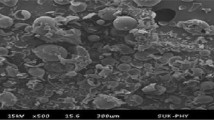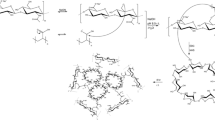Abstract
Current treatments available for human immunodeficiency virus, namely antiretrovirals, do not completely eradicate the virus from the body, leading to life-time commitment. Many antiretrovirals suffer drawbacks from toxicity and unpleasant side effects, causing patience non-compliance. To minimize challenges associated with the antiretrovirals, biodegradable nanoparticles used as drug delivery systems hold tremendous potential to enhance patience compliance. The main objective of this work was to load lamivudine (LAM) into poly(epsilon-caprolactone) (PCL) nanoparticles. LAM is a hydrophilic drug with low plasma half-life of 5–7 h and several unpleasant side effects. LAM was nanoencapsulated into PCL polymer via the double emulsion spray-drying method. Formulation parameters such as the effect of solvent, excipient and drug concentration were optimized for the synthesis of the nanoparticles. Spherical nanoparticles with an average size of 215 ± 3 nm and polydispersity index (PDI) of 0.227 ± 0.01 were obtained, when ethyl acetate and lactose were used in the preparation. However, dichloromethane presented sizes larger than 454 ± 11 nm with PDI of more than 0.4 ± 0.05, irrespective of whether lactose or trehalose was used in the preparation. Some of the nanoparticles prepared with trehalose resulted in crystal formation. UV spectroscopy showed encapsulation efficiency ranging from 68 ± 4 to 78 ± 4 % for LAM depending on the starting drug concentration. Fourier transform infrared spectroscopy and X-ray diffraction confirmed the possibility of preparing amorphous PCL nanoparticles containing LAM. Drug release extended for 4 days in pH 1.3, pH 4.5 and pH 6.8. These results indicated that LAM-loaded PCL nanoparticles show promise for controlled delivery.







Similar content being viewed by others
References
Arpagaus C, Meuri M (2010) Laboratory scale spray drying of inhalable particles: a review, Respir Drug Deliv VCU: 469–473
Baras B, Benoit MA, Gillard J (2000) Influence of various technological parameters on the preparation of spray-dried poly (ε-caprolactone) microparticles containing a model antigen. J Microencapsul 17(4):485–498
Broadhead J, Rouan SKE, Rhodes CT (1992) The spray drying of pharmaceuticals. Drug Dev Ind Pharm 18:1169–1206
Caroline MP, Faulds D (1997) Lamivudine: a review of its antiretroviral activity. Pharmacokinetic property and therapeutic efficiency in management of HIV infection. Drugs 53:7–680
Chernysheva YV, Babak VG, Kildeeva NR, Boury, Benoil F (2003) Effect of the type of hydrophobic polymers on the size of nanoparticles obtained by emulsification–solvent evaporation. Mendeleev Commun 13(2):65–67
Clercq ED (2009) Anti-HIV drugs: 25 compounds approved within 25 years after the discovery of HIV. Int J Antimicrob Agents 33:307–320
das Neves J, Amiji MM, Bahia MF, Sarmento B (2010) Nanotechnology-based systems for the treatment and prevention of HIV/AIDS. Adv Drug Deliv Rev 62:458–477
Dash TK, Konkimalla VB (2012) Poly-є-caprolactone based formulations for drug delivery and tissue engineering: a review. J Control Rel 158:15–33
Dash S, Ng WK, Kanaujia P, Kim S, Tan RBH (2012) Formulation design, preparation and physicochemical characterizations of solid lipid nanoparticles containing a hydrophobic drug: effects of process variables. Colloids Surf B: Biointerf 88:483–489
Dev A, Binulal NS, Anitha A, Nair SV, Furuike T, Tamura H, Jayakumar R (2010) Preparation of poly(lactic acid)/chitosan nanoparticles for anti-HIV drug. Carbohydr Polym 80:833–838
Gupta U, Jain NK (2010) Non-polymeric nano-carriers in HIV/AIDS drug deliveryand targeting. Adv Drug Deliv Rev 62:478–490
Higashiyama T (2002) Novel fuctions and applications of trehalose. Pure Appl Chem 74(7):1263–1269
Inez MV, Kersten G, Marjan MF, Beuvery C, Verhoef JC, Junginger HE (2003) Chitosan microparticles for mucosal vaccination against diphtheria:oral and nasal efficacy studies in mice. Vaccine 21:13–14
Jozwiakowski MJ, Nguyen NT, SiscoI JM, Spancake CW (1996) Solubility behaviour of Lamivudine crystal forms in recrystallization solvents. J Pharm Sci 85:193–199
Jyothi NVN, Prasanna PM, Sakarkar SN, Prabha KS, Ramaiah PS, Srawan, Srawan GY (2010) Microencapsulation techniques, factors influencing encapsulation efficiency. J Microencapsul 27(3):187–197
Kao JH, Wu NH, Chen PJ, Lai MY, Chen DS (2000) Hepatitis B genotype and response to interferon therapy. J Hepatol 33:998–1002
Katata L, Tshweu L, Naidoo S, Kalombo L, Swai H (2012) Design and formulation of nano-sized spray dried Efavirenz-Part I: influence of formulation parameters. J Nanopart Res 14:1247
Kho K, Cheow WS, Lie RH, Hadinoto K (2010) Aqueous re-dispersibility of spray-dried antibiotic-loaded polycaprolactone nanoparticles aggregate for inhaled anti-biofilm therapy. Powder Technol 203:432–439
Kumari A, Yadav SK, Yadav SC (2010) Biodegradable polymeric nanoparticles based drug delivery systems. Colloids Surf B 75:1–18
Look M, Bandyopadhyay A, Blum JS, Fahmy JM (2010) Application of nanotechnologies for improved immune response against infectious diseases in the developing world. Adv Drug Deliv Rev 62:378–393
Luong-Van E, Grondahl L, Nurcombe V, Cool S (2007) In vitro biocompatibility and bioactivity of microencapsulated heparan sulfate. Biomaterials 28:2127–2136
Maia J, Santana M (2004) The effect of some processing conditions on the characteristics of biodegradable microspheres obtained by an emulsion solvent evaporation process. Braz J Chem Eng 21:1–12
Mishra B, Patel BB, Tiwari S (2010) Colloidal nanocarriers: a review on formulation technology, types and application torward targeted drug delivery. Nanomed: Nanotechnol Biol Med 6:9–24
Mourya V, Inamdar N (2008) Chitosan-modifications and applications: opportunities galore. J React Funct Polymers 68:1013–1051
Proikalis CS, Tarantalli PA, Andreopoulos AG (2006) The role of polymer/drug interactions on the sustained release from poly (DL -lactic acid) tablets. Eur Polymer J 42:3269–3276
Rao KS, Ghorpade A, Labhasetwar V (2009) Targeting anti-HIV drugs to the CNS. Expert Opin Drug Deliv 6(8):771–784
Rathbun, R C & Greenfield, R A (2011) Antiretroviral Therapy for HIV Infection. Available: http://emedicine.medscape.com/article/1533218-overview [Accessed 08/11/2011]
Roser B (1991) Trehalose drying-A novel replacement for freeze-drying. Biopharm 4:47–52
Sahoo S, Sasmal A, Nanda R, Phani AR, Nayak PL (2010) Synthesis of chitosan-polycaprolactone blend for control delivery of ofloxacin drug. Carbohydr Polym 79:106–113
Semete B, Booysen L, Lemmer Y, Kalombo L, Katata L, Verschoor J, Swai H (2010) In vivo evaluation of the biodistribution and safety of PLGA nanoparticles as drug delivery systems. Nanomedicine: nanotechnology. Biol Med 6:662–671
Shin IG, Kim SY, Lee YM, Cho CS, Sung YK (1998) Methoxypoly (ethylene glycol)/E-caprolactone amphiphilic block copolymeric micellecontaining indomethacin: I. Preparation and characterization. J Control Release 51:1–11
Simperler A, Kornherr A, Chopra R, Bonnet PA, Jones W, Motherwell WDS, Zifferer G (2006) Glass transition temperature of glucose, sucrose, and trehalose: an experimental and in silico study. J Phys Chem B 110:19678–19684
Song KC, Lee HS, Choung IY, Cho KI, Ahn Y, Choi EJ (2006) The effect of type of organic phase solvents on the particle size of poly(D, L-lactide-co-glycolide) nanoparticles. Colloids Surf A: Physicochem Eng Aspects 276:162–167
Takeuchi H, Yasuji T, Hino T, Yamamoto H, Kawashima Y (1998) Spray-dried composite particles of lactose and sodium alginate for direct tableting and controlled releasing. Int J Pharm 174:91–100
Wong HL, Chattopadhyay N, Wu XY, Bendayan R (2010) Nanotechnology applications for improved delivery of antiretroviral drugs to the brain. Adv Drug Deliv Rev 62:503–517
Woodruff MA, Hutmacher DW (2010) The return of a forgotten polymer—Polycaprolactone in the 21st century. Prog Polym Sci 35:1217–1256
Wu CS (2005) A comparison of the structure, thermal properties, and biodegradability of polycaprolactone/chitosan and acrylic acid grafted polycaprolactone/chitosan. Polymer 46:147–155
Young RJ, Lovell PA (1991) Introduction to polymers, 2nd edn. CRC Press, BocaRaton, New York, Washington, DC, pp 265–266
Zhao Y, Fu J, Dennis KPN, Wu C (2004) Formation and degradation of poly(D, L-lactide) nanoparticles and their potential application as controllable releasing devices. Macromol Biosci 4:901–906
Acknowledgments
The authors would like to thank South African National Research Foundation for providing financial support for the manuscript presented. Thomas Malwela is acknowledged for the SEM analysis of the nanoparticles.
Author information
Authors and Affiliations
Corresponding author
Electronic supplementary material
Below is the link to the electronic supplementary material.
Rights and permissions
About this article
Cite this article
Tshweu, L., Katata, L., Kalombo, L. et al. Nanoencapsulation of water-soluble drug, lamivudine, using a double emulsion spray-drying technique for improving HIV treatment. J Nanopart Res 15, 2040 (2013). https://doi.org/10.1007/s11051-013-2040-4
Received:
Accepted:
Published:
DOI: https://doi.org/10.1007/s11051-013-2040-4




